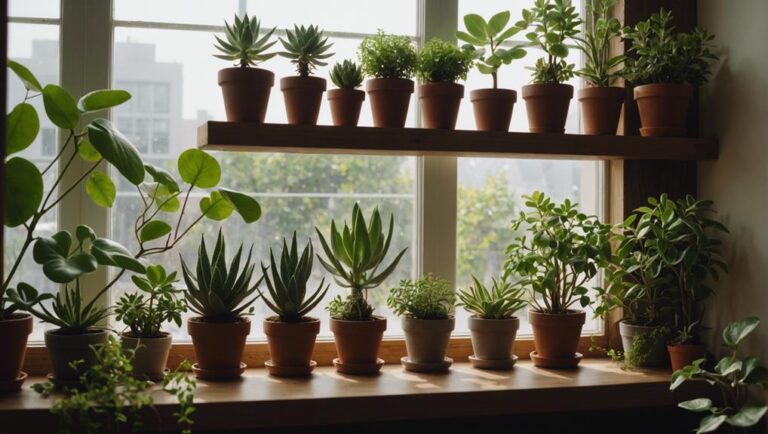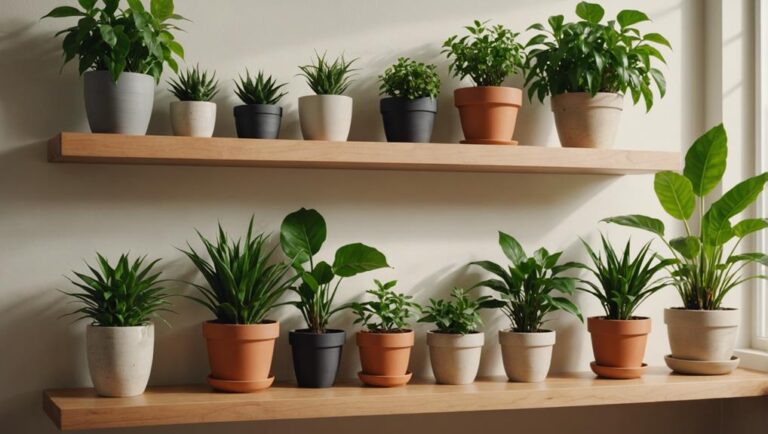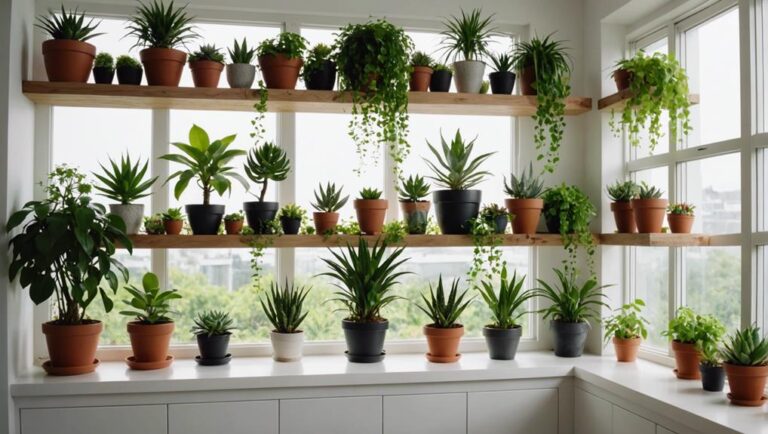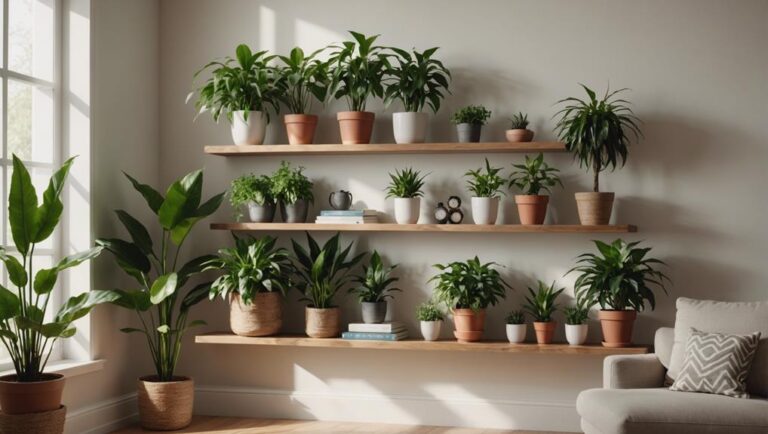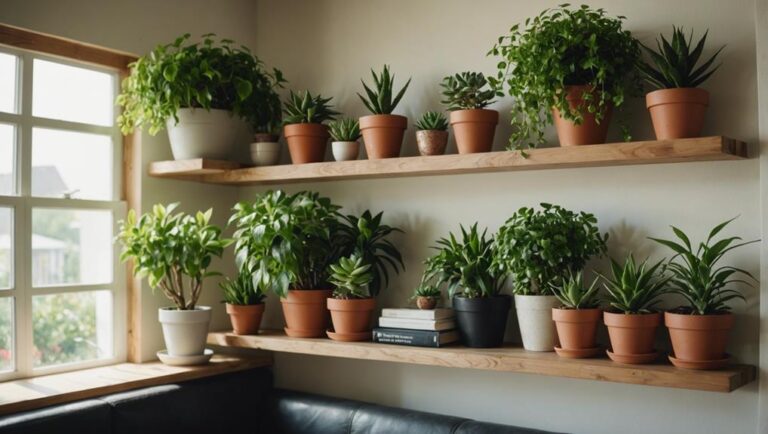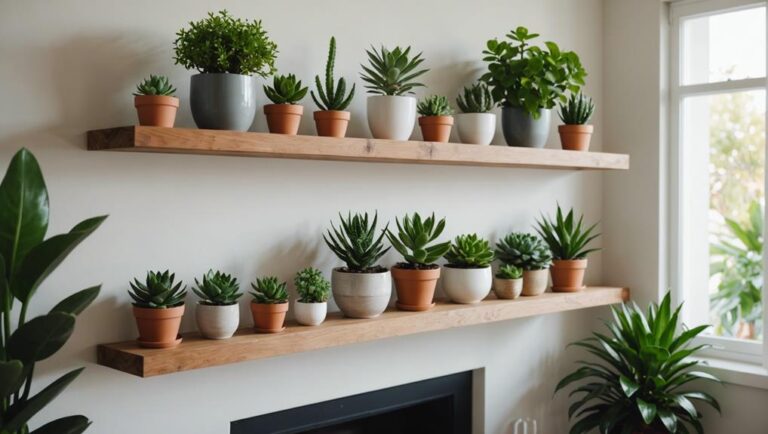Creating a Relaxing Atmosphere With Floating Wood Shelves and Indoor Plants
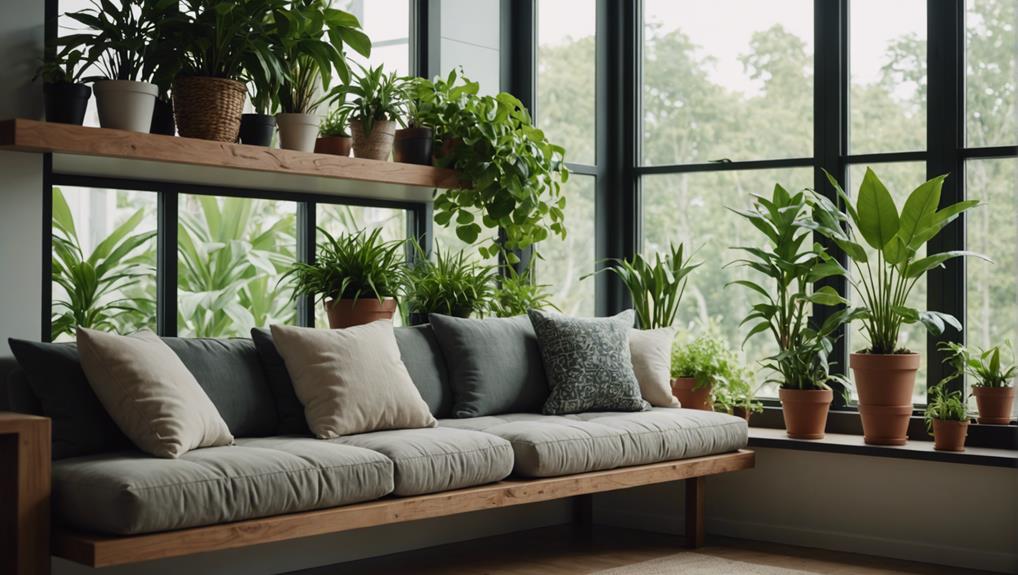
Adding floating wood shelves and indoor plants creates a calm and welcoming ambiance in any room. Opt for oak, pine, or walnut for the shelves to make sustainable choices. Install them at eye level for easy accessibility and stagger their placement for a visually appealing look.
Select low-maintenance plants like Devil's Ivy, succulents, or snake plants to enhance the beauty of the space and improve air quality. Remember that incorporating a variety of plant textures and colors can truly transform your environment into a peaceful sanctuary.
It's crucial to ensure the stability of the shelves and evenly distribute weight for safety purposes. By exploring these simple yet impactful decor changes, you can master the art of creating a tranquil and aesthetically pleasing home environment.
Key Takeaways
- Mount the floating wood shelves at eye level to ensure they are easily visible and accessible.
- Opt for low-maintenance plants such as succulents, snake plants, and air plants to simplify care routines.
- Create a visually captivating focal point by incorporating plants with diverse textures and vibrant colors.
- Maximize corner spaces with corner shelves to showcase unique plant arrangements and enhance the overall aesthetic.
- Keep a close eye on the health of your plants by regularly checking for pests and diseases to preserve a tranquil atmosphere in your space.
Choosing the Right Wood
When setting up a plant display with floating wood shelves, it's essential to choose wood types like sturdy oak, charming pine, or luxurious walnut. These woods not only serve a functional purpose but also bring a touch of natural beauty to your indoor space. Oak's strong grain pattern and rich color are versatile, complementing both modern and traditional decor styles.
Pine, with its lighter and rustic appeal, creates a cozy and inviting atmosphere perfect for showcasing your favorite plants. Meanwhile, walnut's deep, opulent tones add a sophisticated and timeless look to your plant display.
Considering the grain pattern and color of the wood is crucial to ensure it harmonizes with your overall decor theme. Opting for sustainably sourced wood isn't only environmentally friendly but also aligns with your eco-conscious values. Choosing a wood finish that complements your plants and decor enhances the visual appeal and cohesion of your plant display.
To maintain the longevity of your floating wood shelves, it's important to ensure proper treatment and sealing of the wood. This protection guards against water damage from plant care activities, preserving the integrity and beauty of your shelves. By selecting the right wood for your plant display, you create a serene and stylish atmosphere that reflects your commitment to quality and sustainability.
Best Plants for Indoor Shelves
When selecting plants for our floating wood shelf wall display, it's important to choose varieties that thrive in low light conditions and have a compact growth habit. Opt for resilient species like Devil's Ivy and Mother-in-Law's Tongue, known for their adaptability to indoor environments.
For a unique touch, consider incorporating succulents and air plants that require minimal maintenance and add a modern flair to your decor.
By integrating these plant varieties into your floating wood shelf display, not only will you elevate the aesthetic appeal of your space, but you'll also promote a healthier indoor environment. The combination of different textures and colors from the plants will create a visually pleasing focal point that enhances the overall ambiance of the room.
Plus, the air-purifying qualities of these plants can help improve the air quality in your home, making it a more pleasant place to relax and unwind.
Low Light Tolerant Choices
Opting for plants that thrive in low light conditions, such as pothos, snake plants, and ZZ plants, can effortlessly enhance the ambiance of your home when displayed on floating wood shelves. These plants are well-suited for spaces with limited sunlight, making them ideal choices for indoor shelves. Strategically placing them on a shelf not only boosts the visual appeal but also helps create a tranquil and welcoming atmosphere.
Pothos, with their cascading vines, introduce a dynamic and lush element to any room. The vibrant green leaves gracefully spill over the edges of the shelf, bringing a touch of nature indoors.
Snake plants, renowned for their air-purifying properties, are another excellent option. Their upright, sword-like leaves are low-maintenance, making them perfect for individuals with busy schedules.
Lastly, ZZ plants, with their glossy and robust foliage, are virtually indestructible and thrive with minimal attention, making them an excellent choice for beginners in plant care.
Compact Plant Varieties
Compact plant varieties like pothos, spider plants, air plants, succulents, and ferns are excellent choices for adding a touch of greenery to indoor shelves. These plants aren't only visually appealing but also easy to care for, making them ideal for creating a lush and inviting display on floating wood shelves.
Pothos and spider plants are known for their air-purifying qualities and low maintenance requirements, making them perfect additions to our plant display. Their trailing vines and arching leaves bring a dynamic element to the shelves, enhancing the overall aesthetic and promoting a healthy living environment.
Succulents and air plants, with their unique forms and textures, add a modern and sleek look to the plant display. These resilient plants store water in their leaves, requiring minimal watering and care, making them suitable for beginners and busy individuals looking to add some greenery to their space.
Ferns, with their lush foliage and elegant appearance, bring a sense of sophistication and tranquility to indoor spaces. By incorporating these compact plant varieties into our plant display, we create a relaxing atmosphere that's both visually appealing and easy to maintain.
Shelf Placement Ideas
When it comes to showcasing your indoor plants with floating wood shelves, strategic placement is key to creating an inviting and visually appealing display. Opt for mounting the shelves at eye level to ensure that your plants are easily visible and within reach, enhancing the overall atmosphere of the room.
Consider a staggered arrangement to add a dynamic and balanced look, breaking away from the traditional straight lines and infusing a touch of creativity into the space.
Make the most of corner spaces by creatively incorporating floating wood shelves to save space while still providing a unique platform for your plant collection. Grouping shelves together in clusters can create a cohesive and impactful display that draws attention and makes a bold statement in the room.
Mixing and matching shelf sizes and heights adds depth and visual interest, elevating the overall aesthetic appeal of the plant display.
Combining Shelves and Plants
Let's delve into the art of combining floating wood shelves with indoor plants to craft a harmonious ambiance in our living spaces. By strategically positioning these shelves and carefully selecting green companions, we can elevate the visual appeal and air quality of any room.
This fusion not only introduces a slice of nature indoors but also fosters a sense of calm and peace, transforming our rooms into welcoming sanctuaries.
When it comes to floating wood shelves, opt for sturdy, high-quality materials like oak or walnut to ensure both durability and aesthetic charm. These shelves provide a minimalist yet elegant display area for your beloved indoor plants, allowing them to shine as natural decor elements.
Consider incorporating different shelf sizes and shapes to create a dynamic and visually appealing arrangement, adding depth and character to your space.
In terms of indoor plants, choose species known for their air-purifying qualities, such as snake plants, pothos, or spider plants. Not only do these plants enhance the overall ambiance of the room, but they also contribute to a healthier indoor environment by filtering out toxins and releasing oxygen.
Remember to consider the lighting conditions of your space when selecting plants, ensuring they receive adequate sunlight or opting for low-light varieties if needed.
By combining floating wood shelves with carefully selected indoor plants, you can effortlessly infuse your home with a touch of nature and tranquility. This pairing not only adds aesthetic charm but also promotes a sense of well-being and relaxation.
Embrace the beauty of nature within your living spaces and create a serene oasis where you can unwind and rejuvenate amidst the greenery.
Shelf Placement Ideas
Placing floating wood shelves at eye level allows us to showcase our indoor plants effectively, adding a touch of nature to our space. By strategically positioning the shelves, we can create a visually appealing arrangement that combines functionality and aesthetics seamlessly.
To create a captivating display, consider placing trailing plants on higher shelves to achieve a cascading effect, while compact plants can be placed on lower shelves for balance. This not only optimizes the use of vertical space but also enhances the overall visual flow of the room.
Additionally, utilizing corner shelves can be a smart solution for maximizing space in small or tight areas, bringing greenery into the room without occupying valuable floor space.
For a modern and eye-catching look, try combining floating wood shelves with hanging planters. This layered approach adds a dynamic element to the display, making it a focal point in the room.
To add depth and visual interest to the plant arrangement, opt for tiered shelves that allow for a more diverse and engaging presentation of your indoor plants.
Choosing Suitable Plants
When picking plants for our floating wood shelves, we need to think about how they look and how easy they're to take care of. Popular indoor plants like pothos, snake plants, and succulents are great choices. They don't need a lot of attention and can thrive in different conditions, perfect for those with busy schedules who still want some greenery in their homes.
The amount of light in the room is crucial for choosing the right plants. Pothos and succulents do well in bright, indirect light, while snake plants and certain types of ivy can handle low light. Understanding the lighting conditions helps us ensure that our plants not only survive but also grow beautifully.
To create an interesting visual display, we can mix and match plants of different sizes and shapes. Trailing plants like ivy or philodendron can cascade down the shelves, adding depth and dimension.
Choosing plants with diverse textures and colors can make the arrangement vibrant and dynamic, turning our floating wood shelves into a captivating focal point in our space. By carefully selecting and placing our plants, we can achieve a harmonious and visually appealing look.
Minimalist Design Tips
When aiming for a minimalist appearance, opt for sleek, clean-lined wooden shelves and stick to neutral hues like white, black, or natural wood tones. These choices foster a unified, streamlined look that highlights simplicity and refinement. Minimalism transcends mere decluttering; it accentuates the allure of the essentials we showcase.
Arrange your floating shelves with a restrained and harmonious selection of plants to uphold a clutter-free exhibit. Introducing geometric patterns or asymmetrical layouts can infuse a contemporary vibe, ensuring a space that feels inventive and revitalized. Embracing empty spaces is crucial, as it fosters a serene and expansive ambiance in the room.
Here are some essential pointers for upholding a minimalist design:
- Opt for sleek, clean-lined wooden shelves: These exude a contemporary, minimalist aesthetic.
- Adhere to neutral shades: White, black, and natural wood tones maintain a minimalistic and sophisticated visual impact.
- Curtail plant variety: A select few well-chosen plants can make a powerful statement without overwhelming the space.
- Integrate negative space: Allowing for empty areas creates breathing space and amplifies the overall tranquil atmosphere.
DIY Floating Shelves
Let's delve into the world of floating wood shelves for displaying your favorite plants. To get started, gather the necessary materials like sturdy wooden boards, wall brackets, screws, and a level. With these items in hand, you're ready to create a stunning plant display that will elevate the aesthetic of any room.
Begin by marking the desired locations for your floating wood shelves on the wall using a pencil and a level to ensure they're perfectly straight. Then, attach the wall brackets securely to the wall studs, providing a stable foundation for your shelves to rest on. Once the brackets are in place, simply slide the wooden boards onto them, ensuring a snug fit for your plant display to sit securely.
With your floating wood shelves installed, it's time to bring in your favorite plants and arrange them creatively to enhance the visual appeal of your space. Consider mixing different types of plants, varying heights, and adding decorative elements like small pots or wall art to create a dynamic and eye-catching display.
To maintain the beauty of your plant-filled floating wood shelves, remember to water your plants regularly and keep an eye out for any signs of wilting or pests. Additionally, dusting the shelves and wiping them down periodically will help keep them looking fresh and inviting.
Materials and Tools Needed
Crafting your own floating wood shelves for a plant display requires selecting the right materials and tools to ensure both aesthetics and functionality. To create visually appealing and durable shelves, you'll need to carefully choose the materials and have the necessary tools ready.
Start by selecting quality wood boards that complement your desired style and finish. The type of wood and finish are crucial for both the look and longevity of the shelves. You'll also need wood screws and wall anchors to securely mount the shelves. Wall anchors are essential for stability, especially if you plan to display heavier plants on the shelves.
For the crafting process, make sure you have the following tools on hand: a saw for cutting the wood to the correct length, sandpaper for smoothing out edges and surfaces, a measuring tape for precise dimensions, and a level to ensure your shelves are perfectly straight.
A drill will be needed for making holes and securing screws, while a stud finder will help locate the best spots on the wall for mounting the shelves.
Step-by-Step Installation
To start the installation, let's measure and mark the wall for our floating wood shelves. This step is crucial for achieving a sleek and modern look for our plant display. Accurate measurements will ensure proper alignment and balance.
Using a stud finder, locate the wall studs to provide adequate support for our shelves. This is essential to bear the weight of the plants we plan to showcase. If studs aren't available in the ideal spots, we'll need to use wall anchors for stability and security.
After locating the studs or installing anchors, we'll attach the shelf brackets to the wall. Ensuring these brackets are level and securely fixed is key.
Once the brackets are in place, slide the floating shelves onto them for that seamless, floating appearance that adds a sophisticated touch to our plant display.
Styling and Maintenance
Decorating our floating wood shelves with a mix of plants and decor can create a welcoming and balanced atmosphere in our living spaces. By experimenting with different arrangements, we can achieve a look that complements the overall aesthetic of the room.
Incorporating a variety of indoor plants alongside decorative items such as books, vases, and artwork can truly transform these shelves into a captivating focal point.
To maintain this visually pleasing setup, regular dusting is essential. DIY wood shelves, in particular, may require occasional refinishing to ensure they remain in top condition, preserving their beauty and durability over time.
Here are some tips for effective styling and upkeep:
- Visual Harmony: Achieve balance and symmetry by placing similar-sized items on both sides of the shelves.
- Dynamic Display: Create interest by layering items of various heights and textures.
- Seasonal Refresh: Keep things interesting by swapping out decor to suit different seasons or holidays.
- Plant Health: Ensure your plants receive adequate light and water, and repot them as needed to promote their growth and longevity.
Maintaining Plant Health
To ensure the flourishing of our indoor plants displayed on floating wood shelves, it's crucial to regularly monitor them for any signs of pests or diseases. Maintaining plant health is essential for creating a serene ambiance with the elegant combination of wood shelves and greenery. By inspecting the leaves, stems, and soil on a consistent basis, we can promptly address any issues that may arise.
Each plant species has unique watering requirements, so it's important to tailor our watering schedule accordingly. Over-watering can lead to root rot, while under-watering can hinder growth. To promote vibrant foliage and robust development, it's recommended to fertilize the plants based on their individual needs, typically every few weeks during the active growing season.
In addition to watering and fertilizing, pruning plays a vital role in plant care. Trimming away dead or damaged leaves not only enhances the plant's appearance but also stimulates new growth. By shaping the plant through pruning, we can help it thrive and complement our design vision.
Regularly rotating the plants is also crucial to ensure they receive uniform light exposure. This practice promotes balanced growth and prevents the plants from leaning towards the light source, maintaining their structural integrity and aesthetic appeal. By implementing these care routines, we can create a stunning and healthy display of indoor plants on our floating wood shelves.
Lighting Considerations
When incorporating floating wood shelves into our indoor plant display, it's essential to select a wall with optimal indirect lighting to ensure the plants' well-being and vividness. The right lighting not only promotes healthy growth but also enhances the calming ambiance we want to create.
Indirect sunlight plays a vital role in preventing leaf damage while providing sufficient light for photosynthesis. Before deciding on the placement of our floating wood shelves, we should evaluate the natural light levels in the room. In cases where natural light is lacking, we can consider using adjustable LED grow lights to supplement and support optimal plant growth.
Key considerations for lighting include:
- Assessing natural light levels: Understanding the availability of natural light at different times of the day.
- Choosing indirect sunlight: Opting for a spot that receives filtered light to avoid direct sun exposure.
- Utilizing supplemental lighting: Incorporating LED grow lights to compensate for inadequate natural light.
- Opting for adjustable options: Selecting lighting solutions that can be customized to meet the specific requirements of various plants.
Color Coordination
Let's dive into the impact of color coordination on our indoor plant display using floating wood shelves. By selecting colors that complement the natural tones of the shelves, we can create a visually stunning and calming space. Neutral colors such as white, beige, and light wood tones can enhance the greenery of our plants, providing a serene backdrop that doesn't overwhelm the room.
To achieve visual appeal, we should choose plant pots that either contrast or match the wall behind the shelves. This not only highlights the plants but also seamlessly integrates them into the room's design. Experimenting with different color combinations will help us strike the perfect balance between the shelves and the indoor plants, making the space inviting and innovative.
Here's a quick guide to get you started:
| Shelf Color | Wall Color | Pot Color |
|---|---|---|
| Light Wood | White | Beige/White |
| Dark Wood | Light Grey | Black/White |
| White | Dark Blue | Terracotta |
| Beige | Green | Light Wood/Grey |
Seasonal Plant Rotation
Integrating a floating wood shelf into our home decor not only adds a touch of natural beauty but also provides a stylish way to display our beloved plants. Selecting the right plants for this setup is crucial to ensure they receive adequate light and thrive in their environment. By choosing plants that complement each other in terms of care requirements and visual appeal, we can create a stunning botanical display that changes with the seasons.
To enhance the visual impact of our floating wood shelf plant display, we can incorporate a variety of plant sizes, shapes, and textures. This diversity not only adds visual interest but also promotes a healthy and balanced ecosystem for our plants. Mixing trailing plants with upright varieties can create a dynamic and harmonious arrangement that captures attention and brings a touch of nature indoors.
Incorporating seasonal plant rotation into our floating wood shelf display allows us to showcase a constantly evolving array of plants throughout the year. By swapping out plants based on their seasonal preferences and growth patterns, we can ensure that each plant thrives in its optimal conditions. This mindful approach not only keeps our display looking fresh and vibrant but also promotes the overall well-being of our plants.
Choosing Seasonal Plants
Enhance your interior decor by incorporating a variety of seasonal plants on your floating wood shelves. By switching out plants according to their peak growth seasons, you can maintain a dynamic and inviting display all year round. This practice not only adds freshness to your space but also ensures that your plants thrive in optimal conditions.
When choosing seasonal plants for your floating wood shelves, consider factors like light, temperature, and humidity. Each plant has specific requirements that should align with the current season to promote healthy growth. By paying attention to these needs, you can create a visually appealing and flourishing display.
Here are some essential points to consider:
- Light: Ensure that your plants receive adequate sunlight based on their growth stage.
- Temperature: Select plants that are suitable for the temperature in your home during each season.
- Humidity: Choose plants that thrive in the humidity levels of your living space.
- Aesthetics: Experiment with different colors and textures to create an engaging and visually pleasing arrangement on your floating wood shelves.
Rotating for Freshness
Rotating your indoor plants is crucial for maintaining their vibrancy and health. By changing their positions regularly, you ensure that they receive the optimal light and temperature conditions they need to thrive. This practice helps prevent them from growing unevenly or leaning towards a single light source.
It's important to remember that each plant has its own specific requirements. Some plants thrive in bright sunlight, while others prefer a cooler environment. Matching each plant's rotation with its unique light and temperature needs is essential for their well-being.
Regularly checking your plants for signs of stress or excessive growth is also vital. This proactive approach allows you to identify when a plant needs a change of scenery. By staying attentive to your indoor garden, you can keep it dynamic and healthy.
Maintaining Plant Health
To ensure our floating wood shelf plant display thrives year-round, we rotate the plants seasonally to balance light exposure and prevent overexposure. This practice, known as plant rotation, is crucial for optimizing light distribution and maintaining plant health.
By moving the plants to different locations, we can prevent stagnation and promote even growth, ensuring each plant receives the appropriate amount of sunlight it needs.
When planning our plant rotation, we consider the specific light and temperature preferences of each plant type. Some plants thrive in direct sunlight, while others prefer indirect light or partial shade. Regular inspection is essential; we look for signs of stress or disease that might indicate the need for a different environment.
Here's a simple guide to effective plant rotation for your floating wood shelf display:
- Assess plant needs: Identify the light and temperature preferences for each plant type.
- Rotate gradually: Move plants slowly to avoid shock and allow acclimation.
- Monitor health: Check for signs of stress, such as yellowing leaves or stunted growth.
- Adjust placements: Swap plants between high and low light areas seasonally.
Mixing Different Textures
Mixing a variety of textures on your floating wood shelves can completely transform the look and feel of your space, adding depth and interest to your plant display. By pairing sleek ceramic plant pots with rugged woven baskets, you can create a visually captivating arrangement that draws the eye.
The combination of shiny plant leaves against the matte finish of the wooden shelves brings a striking contrast to the overall design, making it more visually appealing.
To elevate the aesthetic further, consider incorporating different textures like glass terrariums alongside metal plant stands on your wooden shelves. This mix adds a sense of sophistication and curated style to the space, enhancing its overall appeal.
The juxtaposition of soft velvet plant holders with sturdy metal decor pieces creates a harmonious and balanced look, enhancing the tactile experience for anyone interacting with the display.
To evoke specific emotions through texture combinations, consider the following:
- Smooth ceramics & baskets: Conveys a sense of comfort and warmth
- Glossy leaves & matte wood: Evokes feelings of freshness and balance
- Glass terrariums & metal: Adds an air of elegance and modernity
- Velvet holders & metal: Creates a feeling of luxury and coziness
- Woven baskets & ceramics: Gives off a rustic and homely vibe
Mixing textures on your floating wood shelves goes beyond just aesthetics; it's about creating a sensory experience that makes your space feel inviting and well-crafted. Embrace the power of texture to innovate and elevate the look of your plant display.
Vertical Space Utilization
Let's dive into creative ways to enhance your living space with floating wood shelves. These shelves not only add a touch of style to your room but also serve a functional purpose by helping you organize and display your indoor plants and decor.
When it comes to vertical space utilization, floating wood shelves are a game-changer. By utilizing the height of your walls, you can create a more spacious and inviting environment, especially in smaller rooms. These shelves not only declutter your surfaces but also offer a unique way to showcase your favorite plants and decorative items.
Maximizing vertical space has numerous advantages. First, it enhances the overall aesthetics of your room. By arranging plants at different heights, you can add visual interest and depth, creating a dynamic and appealing look. Additionally, using vertical space frees up valuable floor space, making your room feel more open and less cluttered.
With floating wood shelves, you can increase the display area for your plants. More shelves mean more opportunities to showcase a variety of plants, adding a calming and nature-inspired touch to your home. Moreover, these shelves efficiently utilize unused wall areas, turning them into practical and beautiful displays that elevate the ambiance of your room.
Incorporating floating wood shelves in your home decor not only adds functionality but also enhances the overall look and feel of your space. So, get creative with your plant displays and make the most of your vertical space with these stylish and practical shelves.
Safety and Stability
Ensuring safety and stability is paramount when setting up floating wood shelves, especially for a plant display. Correct installation plays a crucial role in keeping the shelves secure and functional. It's essential to use appropriate hardware and meticulously adhere to the weight capacity guidelines provided by the manufacturer to prevent any potential accidents.
Regularly examining the shelves for any signs of wear or damage is a proactive measure to maintain their stability over time. Neglecting these routine checks can result in unexpected failures, jeopardizing both the aesthetic appeal and safety of the display.
Avoid overloading the shelves with heavy items as it can compromise their integrity and pose risks. By evenly distributing the weight and adhering to the recommended weight limits, we can enhance the durability and safety of our plant display on floating wood shelves.
Budget-Friendly Options
Looking to create a cozy atmosphere without spending a fortune? Let's dive into some budget-friendly ways to incorporate floating wood shelves and plants into your home decor.
Floating wood shelves offer a stylish and practical solution for any room, especially when combined with indoor plants to bring a calming and welcoming feel to your space.
For a cost-effective approach, consider these tips:
Craft your own floating shelves using affordable materials like plywood or reclaimed wood. Online tutorials can guide you through the process, making it a fun DIY project.
Opt for low-maintenance plants such as succulents, pothos, or spider plants. These options aren't only budget-friendly but also easy to care for, thriving in various indoor environments.
Choose simple shelf designs with clean lines and natural finishes to keep costs down and enhance the peaceful ambiance of your room.
Explore thrift stores or garage sales for second-hand shelves and plant pots. With a touch of creativity, you can transform these budget-friendly finds into beautiful and unique decor pieces.
Enhancing Small Spaces
Floating wood shelves maximize vertical space, transforming small rooms into stylish and functional areas. Elevating storage solutions frees up valuable floor space, making cozy corners feel open and inviting. These shelf ideas blend form and function seamlessly, perfect for those seeking a practical yet stylish touch in their homes.
Floating wood shelves offer versatility, easily installed at varying heights to suit individual needs, customizing each space with precision. Adding indoor plants introduces a natural element, creating a calming and relaxing atmosphere. The greenery not only enhances the aesthetic appeal but also contributes to a sense of tranquility, making small spaces feel like serene retreats.
Strategically placing floating shelves with plants in cramped areas can dramatically transform them. A once-overlooked corner can become a cozy, tranquil spot in our home, with the combination of wood and foliage visually expanding the room.
These shelf ideas harness the power of vertical space, turning limited square footage into a stylish, functional haven. Enhancing small spaces with floating wood shelves and plants ensures they're both beautiful and practical.
Frequently Asked Questions
How to Style Floating Shelves With Plants?
Let's decorate our floating wood shelves by selecting trailing plants like pothos for a cascading effect. Vary the heights of the plants, incorporate air plants or succulents for easy maintenance, and arrange them in odd numbers for a visually pleasing display.
When styling floating wood shelves with plants, consider the overall aesthetic you want to achieve. Choose plants with different textures and colors to create visual interest. Mixing in plants with varying leaf shapes can add dimension to the display. Additionally, incorporating plants with different growth habits, such as vines or compact succulents, can contribute to a dynamic and harmonious arrangement.
To enhance the natural beauty of the plants, complement them with decorative elements like small sculptures, candles, or natural materials such as driftwood or stones. These additions can help tie the plant display into the overall decor of the room and create a cohesive look.
Remember to regularly water and care for the plants to ensure they thrive in their new environment. Consider the lighting conditions near the floating shelves and choose plants that are well-suited to the available light levels. By paying attention to these details, you can create a stunning and inviting plant display on your floating wood shelves.
What Is the Best Plant for Floating Shelves?
Air plants are the ideal choice for floating wood shelves. They require no soil and can thrive in a variety of conditions, making them versatile and easy to care for. When displaying air plants on your shelves, the key is to select containers that are innovative and stylish, as these can enhance the overall aesthetic of your space.
Air plants, scientifically known as Tillandsia, are unique in that they do not require soil to grow. Instead, they absorb nutrients and moisture through their leaves, making them perfect for displaying on floating wood shelves. Their ability to adapt to different environments makes them a popular choice for indoor plant displays.
When selecting containers for your air plants, consider options that are not only functional but also visually appealing. Look for holders that complement the natural beauty of the air plants and enhance the overall design of your floating wood shelves. By choosing innovative containers, you can create a striking and stylish plant display that adds character to your space.
Can Floating Shelves Hold Plants?
Floating wood shelves are perfect for displaying your favorite plants in a stylish and space-saving way. With the right planning and sturdy brackets, these shelves can easily support the weight of your plants and become a focal point in your home decor. Whether you have a small collection of succulents or a lush display of trailing vines, floating wood shelves provide a versatile and charming backdrop for your botanical beauties.
When choosing floating wood shelves for your plant display, be sure to consider the weight capacity of the shelves. Opt for high-quality shelves with strong brackets to ensure they can safely hold your plants without sagging or bowing. By selecting shelves that can support the weight of your plants, you can create a stunning and functional plant display that adds a touch of nature to any room in your home.
With a little bit of creativity and the right floating wood shelves, you can transform any wall into a green oasis. Mix and match different shelf sizes and heights to create visual interest, and experiment with arranging your plants in a way that showcases their unique shapes and colors. Whether you're a seasoned plant parent or just starting to explore the world of indoor gardening, floating wood shelves offer a versatile and stylish way to bring the beauty of nature into your home.
What Is the Best Layout for Floating Shelves?
For the optimal layout, consider staggering floating wood shelves at different heights. Focus less on symmetry and instead embrace asymmetrical arrangements for a more visually interesting display. When grouping items, aim for odd numbers as they tend to create a more balanced and aesthetically pleasing look. Additionally, balance larger planters or decorative items on lower shelves with smaller ones placed higher up to create a sense of harmony in your plant display.
Conclusion
By merging exquisite, floating wood shelves with lush, vibrant plants, we craft a serene and unified living space. Through meticulous consideration of wood varieties, plant assortments, and strategic shelf positioning, any room can be utterly transformed.
Emphasizing safety, stability, and simplicity ensures our design is both captivating and secure. By cleverly utilizing vertical space and opting for cost-effective choices, we enhance the appeal of even the most compact areas.
Let's embrace this refined, environmentally conscious approach to effectively elevate our indoor surroundings.

